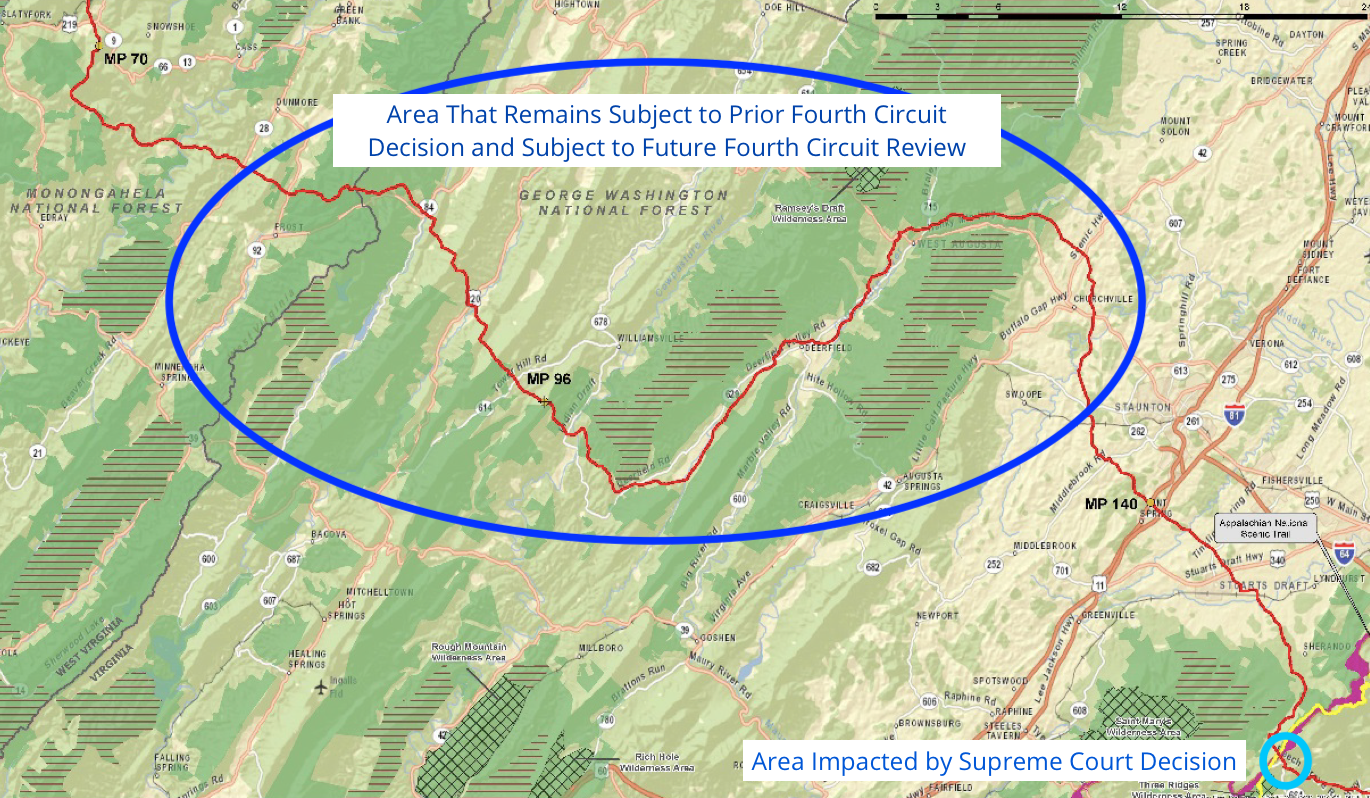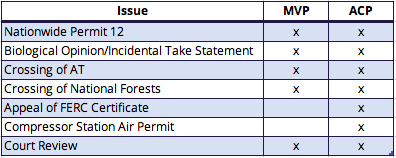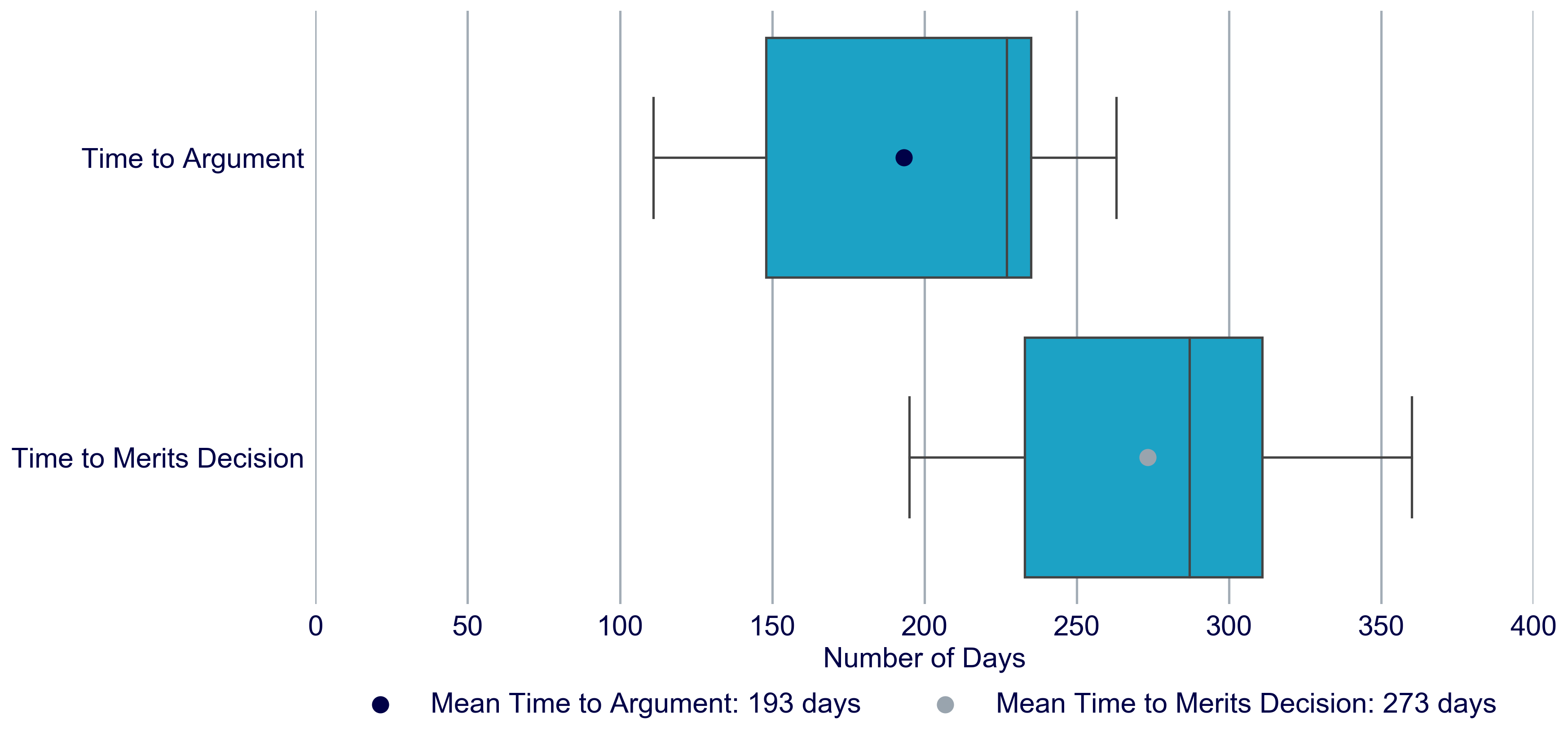ACP Wins at the Supreme Court — Necessary But Not Sufficient for ACP and MVP
What’s the issue?
On Monday the Supreme Court issued its decision in the case brought by Atlantic Coast Pipeline seeking to overturn the lower court’s decision that voided the permit issued to allow the project to cross the Appalachian Trail.
Why does it matter?
Because the court ruled in favor of ACP, the project should be able to obtain the permit it needs to cross the AT. More importantly for the industry as a whole, however, an adverse decision would have created thousands of miles of roadblocks to pipeline development far beyond the AT.
What’s our view?
While this is good news for the industry, both ACP and MVP still need a number of permits reissued and will need the Fourth Circuit to uphold all of them before they can complete construction. We see this process likely delaying MVP to late 2021 and ACP to late 2022.
On Monday the Supreme Court issued its decision in the case brought by Atlantic Coast Pipeline (ACP) seeking to overturn the lower court’s decision that voided ACP’s permit allowing it to cross the Appalachian Trail (AT).
We predicted back in January in The Odds of Atlantic Coast Pipeline Winning at the Supreme Court, that the likely outcome of the case would be “a 7-2 vote with only Justices Kagan and Sotomayor voting to uphold the decision by the Fourth Circuit.” While predicting court decisions is not a precise science, our analysis of the voting patterns of the individual justices in cases involving appeals by a federal agency regarding a lower court’s interpretation of a federal statute -- the precise circumstance at issue -- allowed us to call this one correctly, as that is exactly how the votes went in Monday’s ruling. More importantly for other projects, especially Mountain Valley Pipeline (MVP), the seven justices all agreed on a fairly broad basis for overturning the lower court’s decision.
While the decision is a critical one for ACP, that project and MVP still face substantial challenges, which we discuss in more detail below. We believe the Fourth Circuit remains skeptical of the diligence of the project reviews by the current administration and this has resulted in apparent hostility to both projects, which could lead to stays of construction while that court reviews any reissued permits. In addition, as long as the permits are issued by the current administration, the projects may face viability concerns. Given the likelihood of stays being imposed, we think it likely that MVP will be delayed to the end of 2021, and ACP to the end of 2022. Perhaps the simplest visualization of remaining hurdles is depicted below in the map of ACP’s crossings of national forest lands.

As seen above, the tiny area in the lower right hand corner is the portion of the project that is impacted by the Supreme Court’s decision. Basically, the rest of the map remains subject to the Fourth Circuit’s original decision to also void the permit issued by the Forest Service to allow ACP to cross the Monongahela and Washington National Forests. This is just one of many issues that both ACP and MVP still must overcome to put the projects into service.
Winning at the Supreme Court
The Supreme Court decision issued on Monday is about as positive of a decision as ACP, MVP and the pipeline industry could have hoped for. Justice Thomas’s majority opinion, joined almost in its entirety by six other justices, relies on the broadest possible basis for overturning the lower court’s decision. As Justice Thomas states in the opinion, in cases of complex statutory interpretation like this one, it is important to not “miss the forest for the trees” because, as his opinion ultimately finds: “A trail is a trail, and land is land.”
Justice Thomas acknowledges that the case is difficult, because the United States owns all of the land rights involved here but has split those rights between two agencies, the U.S. Forest Service and the National Park Service. However, he then relies on the fact that when Congress created the AT, it used language similar to an easement grant that kept ownership of the “land” in the Forest Service, but granted an easement for the AT to the Park Service. This is critical because, as in private land transactions, the granting of an easement does not divest the landowner of its right to grant additional easements. Thus, even though the Park Service has an easement for the AT, the Forest Service retains the right to grant additional easements to pipelines like ACP and MVP.
In what must be a very welcome contrast for ACP, Justice Thomas distinguishes the actions of Congress with respect to the AT to the language it used for the Blue Ridge Parkway. He notes that when Congress created the Blue Ridge Parkway, it authorized the Department of the Interior “to transfer to the jurisdiction of the Secretary of Agriculture for national forest purposes lands or interests in lands acquired for or in connection with the Blue Ridge Parkway” and Congress further specified that “[l]ands transferred under this Act shall become national forest lands.” As reasoned by Justice Thomas, the fact that “Congress chose to speak in terms of rights-of-way” with respect to the AT, “rather than in terms of land transfers, reinforces the conclusion that the Park Service has a limited role over only the [AT], not the lands that the [AT] crosses.” Given that the little circle in the map above includes a crossing of both the AT and the Blue Ridge Parkway and that in a separate case, the Fourth Circuit also voided ACP’s right to cross the Parkway, this language in the decision may become critical to having that easement restored as well.
The Road Ahead Remains Difficult for ACP and MVP
About one year ago in MVP and ACP – Similar Projects, Similar Problems, Different Paths, we noted that MVP and ACP were facing very similar challenges.

While each of these issues are deserving of their own in-depth analysis, we will quickly summarize the status of each of them and then consider how appellate court review, and particularly the Fourth Circuit’s review, creates both a timing and viability risk to both projects.
Nationwide Permit 12
In Suspension of NWP12 May Cause Nine-Month Delays for Pipeline Projects, Including MVP, we discussed the decision by the Ninth Circuit to leave in place a prohibition against the use of NWP12 for new oil and gas projects that was issued by the Montana District Court. On the same day that the Supreme Court decided the ACP case, the Solicitor General on behalf of the U.S. Army Corps of Engineers (USACE) filed an application to Justice Elena Kagan asking her to stay that decision while the appeals process works its way through the Ninth Circuit.
As explained in that application and in our prior Insights, a single justice or the Court may stay a district court order pending appeal to a court of appeals. In his application for a stay, the Solicitor General notes that the factors the single justice or the Court should consider in granting such a stay is “whether four Justices are likely to vote to grant certiorari if the court of appeals ultimately rules against the applicant; whether five Justices would then likely conclude that the case was erroneously decided below; and whether, on balancing the equities, the injury asserted by the applicant outweighs the harm to the other parties or the public.” Not surprisingly, the Solicitor General then spends almost forty pages trying to persuade Justice Kagan that “all of those factors counsel strongly in favor of a stay” of the lower court’s decision blocking use of NWP12 for new oil and gas pipelines.
It is likely that the court will rule on this request prior to adjourning for the summer, because to do otherwise is essentially the equivalent of denying the request. However, even if the Supreme Court decides to stay the lower court’s decision, both ACP and MVP need to obtain a reverification under NWP12 from the USACE and that can only be done once the consultation is concluded about endangered species, which we discuss next. In addition, any decision under the Clean Water Act, whether through use of NWP12 or a project-specific permit, will be subject to review by the Fourth Circuit.
Biological Opinion/Incidental Take Statement
Both ACP and MVP have had their previous endangered species reviews voided by the court or revoked by the U.S. Fish and Wildlife Service (USFWS). FERC restarted the formal consultation process for both projects last year. ACP has indicated that it expects this process to conclude by the end of June and MVP expects a revised biological opinion in July. On May 28, the USFWS notified the Fourth Circuit that its consultation with FERC regarding MVP had concluded and it was in the process of drafting a revised biological opinion and incidental take statement. We fully expect both decisions once issued to be appealed once again to the Fourth Circuit.
Crossing of the AT
The Supreme Court decision should resolve any question about the authority of the Forest Service to approve a crossing of the AT. However, the Forest Service will still need to provide such a permit in a manner that can survive a review by the Fourth Circuit of the process it follows to issue such a permit.
Crossing of the National Forests
Both ACP and MVP have had the permits issued by the Forest Service authorizing them to cross their respective national forests voided by the Fourth Circuit. Earlier this month, the Forest Service issued a notice indicating that it was going to prepare a Supplemental Environmental Impact Statement (SEIS) as part of its review of ACP’s permit. That notice indicated that it hoped to issue the draft SEIS in July and the Final SEIS “later in 2020.” Given the expected number of comments, we would anticipate that “later” will be much later in 2020. We have not seen a similar notice for MVP, which could indicate that the Forest Service is not anticipating needing one, which seems unlikely, or more likely that it is not yet prepared to issue such a notice for the MVP crossing.
Appeal of FERC Certificate
The appeals of MVP’s FERC certificate have been resolved. However, a number of appeals of the ACP certificate, even by ACP itself, are pending before the DC Circuit and were put on hold while the Supreme Court considered the AT crossing decision. Since that decision has now been issued, we expect that the DC Circuit will set a briefing schedule for the appeals.
Compressor Station Air Permit
Earlier this year, the Fourth Circuit voided the air permit that the state of Virginia had issued for one of ACP’s compressor stations. We expect that the Virginia Department of Environmental Quality will reissue that permit in a manner that will ultimately win approval by the Fourth Circuit, but because this permit is not needed for the pipeline itself to go into service, we do not consider it an overall risk to the timing or viability of the project as a whole.
Appellate Court Review
All of the permits we describe above, other than the FERC certificate for ACP, will eventually be appealed to the Fourth Circuit. We now have a dataset for how long it takes for the Fourth Circuit to issue decisions on appeals of these related permits:

As seen above, the Fourth Circuit takes, on average, over six months from the time a permit is appealed until it hears the oral argument in the case. Further, it takes the court, on average, nine months to actually issue its decision. So if we assume that for at least one of the permits to be issued, the Fourth Circuit will impose a stay at least until it hears arguments or perhaps until it issues a decision, this six to nine month period must be added to the end of the time period we expect it will take for each project to be allowed to start construction. It is this extension of the time frames for these permits that leads us to the conclusion that the projects face more substantial delays than either currently anticipates. While we understand that their time frames are most likely based on an assumption that the Fourth Circuit will not issue a stay, we do not think that is a reasonable assumption given the Fourth Circuit’s apparent skepticism about the current administration and its reviews of the permits.
Finally, a key risk for both projects is that the Fourth Circuit simply denies a permit and the agency is unable to fix the permit in a manner that allows the project to be completed. Because there are multiple permits, even if we assume a high likelihood of winning for each permit, the odds of winning them all, which is required to complete the project, begin to diminish. It is this risk that we believe creates a viability risk for both projects.